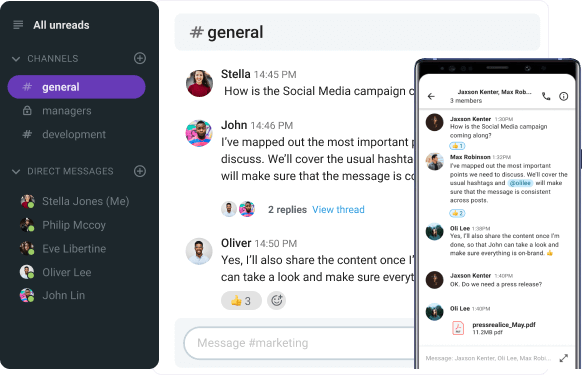So, you think formal communication is a thing of the past? Think again.
Even as modern-day organizations are getting increasingly casual about dress codes, hierarchies, and etiquette, the importance of formal communication can’t be understated.
After all, these formalities are sometimes the only thing standing between us and total chaos at work.
With that in mind, we thought we should take some time to define formal communication and talk about:
- Its characteristics,
- The main types of formal communication we might use in the workplace, and
- How you can improve the way you use formal communication in your everyday life.
But first, let’s start by answering the big question — what is formal communication, anyway?
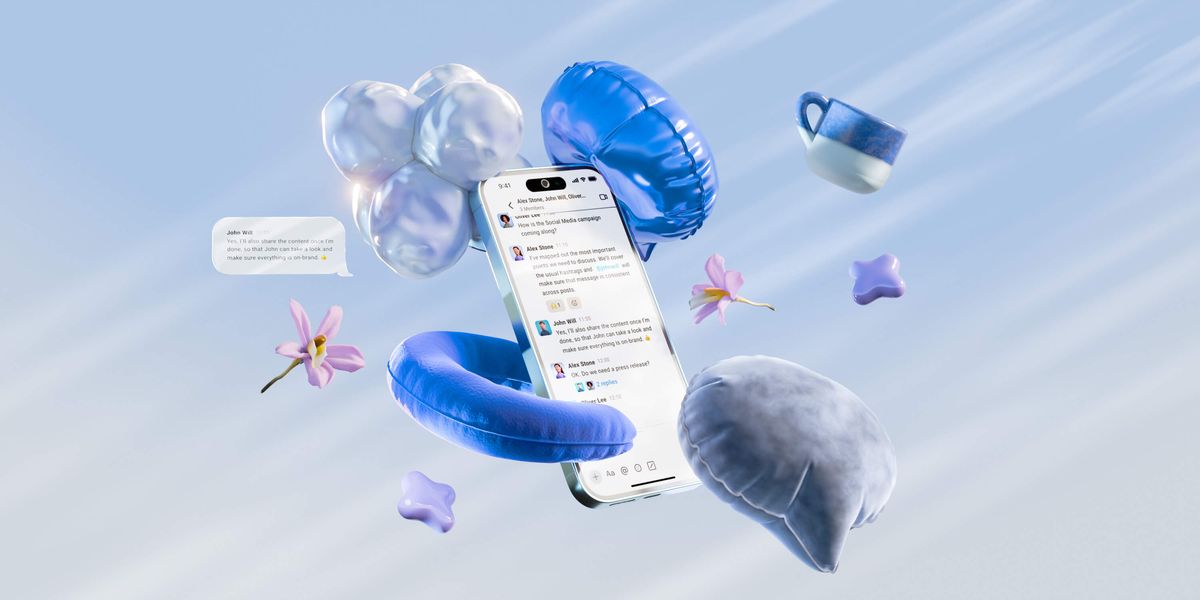
Table of Contents
What is formal communication?
Formal communication is a style of communication typically used to convey information through predefined channels in organizations that have strong hierarchical structures and tend to enforce strict rules of engagement.
This type of exchange is usually documented or put in writing, as noted by Anitra St. Hilaire, an executive coach and VP of People with over 15 years of experience in human resources:

“Formal communication is structured, intentional, and typically documented communication that reflects the official voice of an organization. It includes things like policies, standard operating procedures, handbook language, and official announcements. These are the reference points that people return to when they need clarity, and they often serve as the organization’s ‘source of truth.’”
According to the Director of Human Resources, Tawny Lott Rodriguez, SHRM-SCP, formal communication is all about clear expression:

“When I think about formal communication, I picture the official channels and messages that help keep a company running smoothly. It’s those emails, meetings, reports, or announcements that follow a clear, intentional path. They are designed to deliver important information in a way that leaves little room for confusion.”
Of course, even though emails and newsletters are fairly standard ways to convey official information in organizations, many companies also use their internal communication software as one of the predefined channels for formal communication, as shown by the example below.
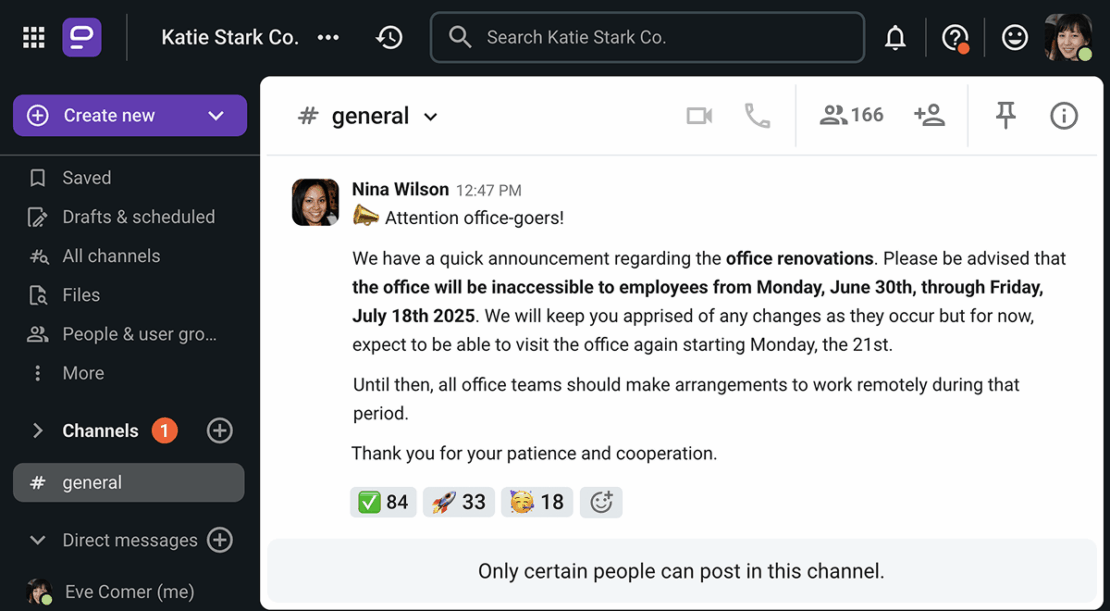
Share company announcements on Pumble
If this formal communication definition seems too vague, let’s clear it up by exploring more characteristics that define formal communication in greater detail.
What are the main characteristics of formal communication?
To gain a better understanding of formal communication, we wanted to pinpoint some of its main characteristics.
According to Tawny Lott Rodriguez, formal communication tends to be documented, respectful, and transparent:

“Formal communication is:
- Clear,
- Respectful, and
- Organized.
It tends to be documented, whether in writing or recorded in meetings. That means you can look back and see exactly what was said or decided. The tone is usually professional and polite. One thing I always notice is how formal communication tries to be as transparent as possible — it’s meant to make sure everyone has the same understanding.”
On the other hand, Anitra St. Hilaire highlighted purpose and structure as the main characteristics of formal communication:

“To me, formal communication is defined by:
- Tone,
- Structure, and
- Purpose.
It’s usually written, often written in a company’s ‘voice’, and comes with an expectation that it will be preserved, referenced, and relied upon. It aims to create consistency and eliminate ambiguity.”
In other words, the main characteristics of formal communication are:
- Clarity, as the goal is to make sure everyone understands the message,
- Efficiency, as it conveys information in the simplest and most impersonal terms, and
- Structure, which prompts us to adhere to the established chain of command and follow the predefined rules of the organization.
Then again, the characteristics of formal communication may actually be more contextual, as Dean Batson, the Instructor of Business Communication at Arizona State University, told us:

“Formal communication looks very different across industries, regions, and especially generations. What feels respectful in one context can come off as cold or performative in another.”
Still, it should be easy to see the differences between formal and informal communication, at least. So, let’s point them out.
What is the difference between formal and informal communication?
Perhaps the most obvious difference between formal and informal communication is the fact that formal communication goes through predefined, official channels, whereas informal or grapevine communication can take place outside of those channels and ignore the rules of formal communication.
You can see some of the other differences between these two styles of communication in the table below.
| FORMAL COMMUNICATION | INFORMAL COMMUNICATION | |
|---|---|---|
| STRUCTURE | Predefined channels (email, newsletters, certain channels within the company’s messaging app) | Casual channels (direct messages, video and voice calls, in-person meetings) |
| PURPOSE | Conveying official information | Establishing personal connections |
| HIERARCHY | Typically used for vertical communication (between employees and superiors in either direction) | Typically used with people we are on friendly terms with |
| TONE | Professional, polite, and impersonal | Warm and friendly |
| DOCUMENTATION | On the record | Off the record |
Because of these factors, formal communication is also more time-consuming than informal communication, as it requires forethought and approval before transmission.
Conversely, informal communication is mostly used for building trust, as Anitra St. Hilaire put it:

“Informal communication helps:
- Build trust,
- Drive quick alignment, and
- Pinpoint surface issues early.
The best communicators know when to shift gears. Formal channels should set the tone and expectations; informal channels should reinforce, clarify, and humanize them.”
Ideally, we should use both formal and informal communication, as Tawny Lott Rodriguez noted:

“Informal communication is where relationships grow and ideas spark, but formal communication makes sure those ideas turn into action. When I’ve seen teams over-rely on formal communication without informal moments, things get rigid and slow. On the flip side, too much informal communication without clear formal updates can lead to confusion and missed expectations.”
Now that we have a firm grasp on what formal communication is and what it isn’t, let’s dive deeper into different types of formal communication.
What are the types of formal communication?
As we have just mentioned, one of the main characteristics of formal communication is that it’s typically used to convey information vertically — that is, between employees and higher-ups.
In this case, formal communication can go in both directions, namely:
- Downward, when higher-ups need to pass information along to subordinates through newsletters, emails, all-hands meetings, etc., and
- Upward, when employees need to convey official information to their supervisors through reports and presentations as well as emails and direct messages.
On top of this, a formal conversation can also be a part of:
- Horizontal communication, which indicates an exchange of information between hierarchical peers, as well as
- Diagonal communication, which is when an employee needs to report to a higher-up who is not their direct superior or vice versa (so, a manager contacting an employee from a different department).
Here’s what that last communication situation might look like on Pumble, the team communication app.
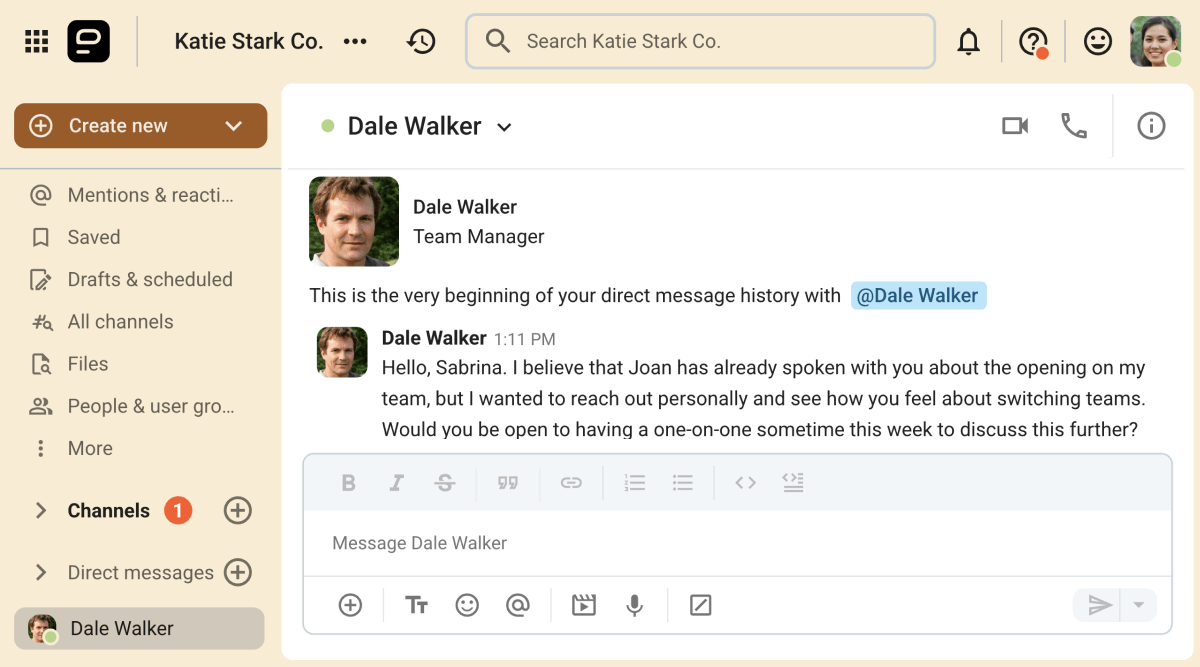
Reach out to coworkers on Pumble
All these types of formal communication can be expressed through various communication channels — which we’re about to discuss.
What are formal channels of communication?
As we know, formal communication requires the use of predefined channels, which tend to be influenced by a company’s approach to internal communication.
Typically, though, formal channels of communication include:
- Email,
- News bulletins,
- Business messaging apps,
- Letters and printed statements, and
- Digital channels such as the company website, internal forums, intranet, etc.
Though most of these formal communication channels can only be used in one way, a business messaging app like Pumble can be used to convey formal communication in many different ways.
In addition to being able to communicate in writing, Pumble also allows you to host meetings and video conferences and even record them for future reference — as shown by the image below.

Host virtual conferences with Pumble
In other words, messaging apps allow you to take advantage of multiple channels of formal communication and still have everything documented, which is one of the primary characteristics of formal communication.
Why is formal communication important?
Even though many companies have been encouraging their employees to communicate more informally amongst themselves, formal communication is still necessary for certain situations.
With that in mind, let’s highlight the importance of formal communication by discussing some of its benefits.
Benefit #1: Formal communication is clear and reliable
In a formal conversation, participants pay attention to the clarity of their message above all else, leaving little room for misunderstanding or misinterpretation.
This is one of the main benefits of practicing formal communication in the workplace, as Anitra St. Hilaire told us:

“The most powerful benefit is clarity of expectations. When formal communication is crafted thoughtfully, with plain language, grounded in the company’s values, and focused on transparency and accessibility, it removes confusion and reduces the likelihood of conflict. One of the most common root causes of workplace friction is misaligned expectations. A strong, clear formal message can solve a problem before it ever becomes one.”
In other words, using formal communication minimizes the risk of miscommunication, which has been known to cause other communication breakdowns in the workplace.
Benefit #2: Formal communication is available for future reference
As we have previously mentioned, most types of formal communication are documented in one way or another.
On the one hand, technological advancements allow us to easily search through our written communication, as long as it was exchanged through email or an employee communication app like Pumble.
Even when a formal conversation takes place in an in-person or virtual meeting, the topics covered are usually documented through meeting minutes or in the form of a video recording.
Because of that, most instances of formal communication remain available for future reference, allowing us to keep both ourselves and our coworkers accountable. According to Tawny Lott Rodriguez, that is one of the biggest benefits of formal communication:

“When a message is carefully crafted and sent through official channels, it creates a record of what was shared and who is responsible for what. This reduces misunderstandings and holds people to their commitments.
In HR, this is huge because we deal with sensitive topics like compliance, performance reviews, and employee concerns where clarity and documentation matter. For example, I remember a situation where a formal follow-up email after a meeting helped prevent a major mix-up on project deadlines because everyone had the same clear information to refer to. That kind of clarity saves time and energy and reduces stress.”
In fact, saving time is another huge benefit of formal communication.
💡 PUMBLE PRO TIP
Pumble’s unlimited message history allows you to instantly find any information you need to access. To learn more about how you can simplify your search for knowledge, check out this guide:
Benefit #3: Formal communication saves time
As time-consuming as formal communication can be while we’re crafting these official messages, its purpose is to actually conserve time for everyone involved.
After all, carefully formulating your message to make it clear and simple to understand should reduce the number of follow-up questions you’ll have to answer.
And, even if you happen to receive a question about something you’ve already answered elsewhere, whether it was in a messaging app channel or on the company wiki, you can just redirect the person to the location of the answer, as seen below.

Discuss company policies on Pumble
Benefit #4: Formal communication helps leadership stay in full control
As we have established, formal communication is often used to convey official information to a group of people at the same time in the form of company memos and announcements.
With that in mind, one of the major benefits of this type of communication is that it minimizes the risk of rumors and anxious or hurt feelings.
In other words, formal communication helps leadership manage the way employees feel about the company and its decisions.
On top of that, receiving a message that’s been carefully crafted to minimize misunderstandings also ensures that whatever news you’re sharing can’t be distorted when making the rounds among employees.
This is especially important when it comes to announcing changes, which can cause confusion and negative feelings if not handled properly.
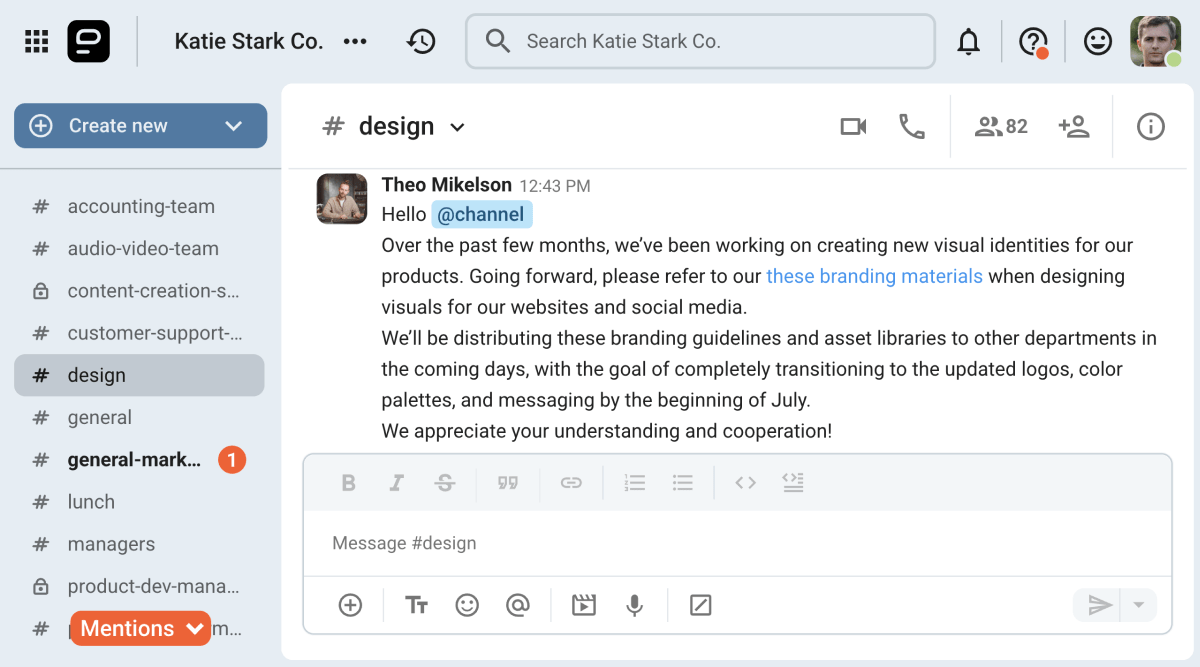
Benefit #5: Formal communication feels less personal
As we know, formal communication is impersonal — on purpose.
That’s actually one of its benefits.
It allows us to stay objective by suppressing our personal emotions, biases, and prejudices.
However, that doesn’t mean that formal communication should be completely devoid of empathy.
We can still practice empathetic communication even in formal situations, as long as we consider the way our message will come across to the audience before we hit that send button.
But, that’s not the only way to improve our formal communication skills.
5 Tips for improving formal communication
Before we go into our tips for improving your formal communication skills, we wanted to take a second to remind you that the rules of formal communication are largely circumstantial.
As Dean Batson told us, the real skill you need to develop isn’t perfect formality, but rather, adaptability:

“The real professional skill today isn’t perfect formality, it’s communication adaptability: knowing how to shift tone, medium, and message depending on who you’re talking to and how you’re connecting.
The challenge is, the generations that were taught one rigid model of ‘formal’ often mistake that flexibility for disrespect and they lash out at those adapting faster than they did.”
So, our first tip to you is that you should work on becoming a more adaptable communicator, so that you can adjust the level of formality depending on the situation.
With that being said, if you ever end up in a situation that calls for a higher degree of formality, you should be able to coast through it by employing the following tips.
Tip #1: Use official titles and address people formally
Even though referring to people as Mr., Mrs., and Miss can feel a bit archaic, these polite forms of address are one of the primary indicators of formal communication.
So, if you want to get better at this type of communication, you might as well take up the habit of referring to other people by their official titles, job positions, or just by using Mr. or Ms. and their last name.
Note: this type of address should be reserved for official documents, letters, and emails. People usually use more relaxed forms of address on group messaging apps like Pumble.
💡 PUMBLE PRO TIP
The use of internal messaging apps to facilitate workplace communication has created a new type of messaging etiquette. To learn more about that, read this guide:
Tip #2: Use formal language
Even if you’re sticking to first names, there’s still a way to increase the formality of your conversation.
For one, you should make sure to use clear and precise language to avoid ambiguity.
On top of that, you should also avoid using contractions, as shortening phrases is one of the main characteristics of informal communication.
Minimizing the use of singular personal pronouns can also make it clear that you’re talking about the company’s decisions instead of your personal preferences.
So, instead of telling someone: “You are not allowed to smoke in the building.”
Use the passive voice: “Smoking is not allowed anywhere in the building.”
Last but not least, you should also avoid slang, as the use of informal expressions in a professional environment may cause confusion.
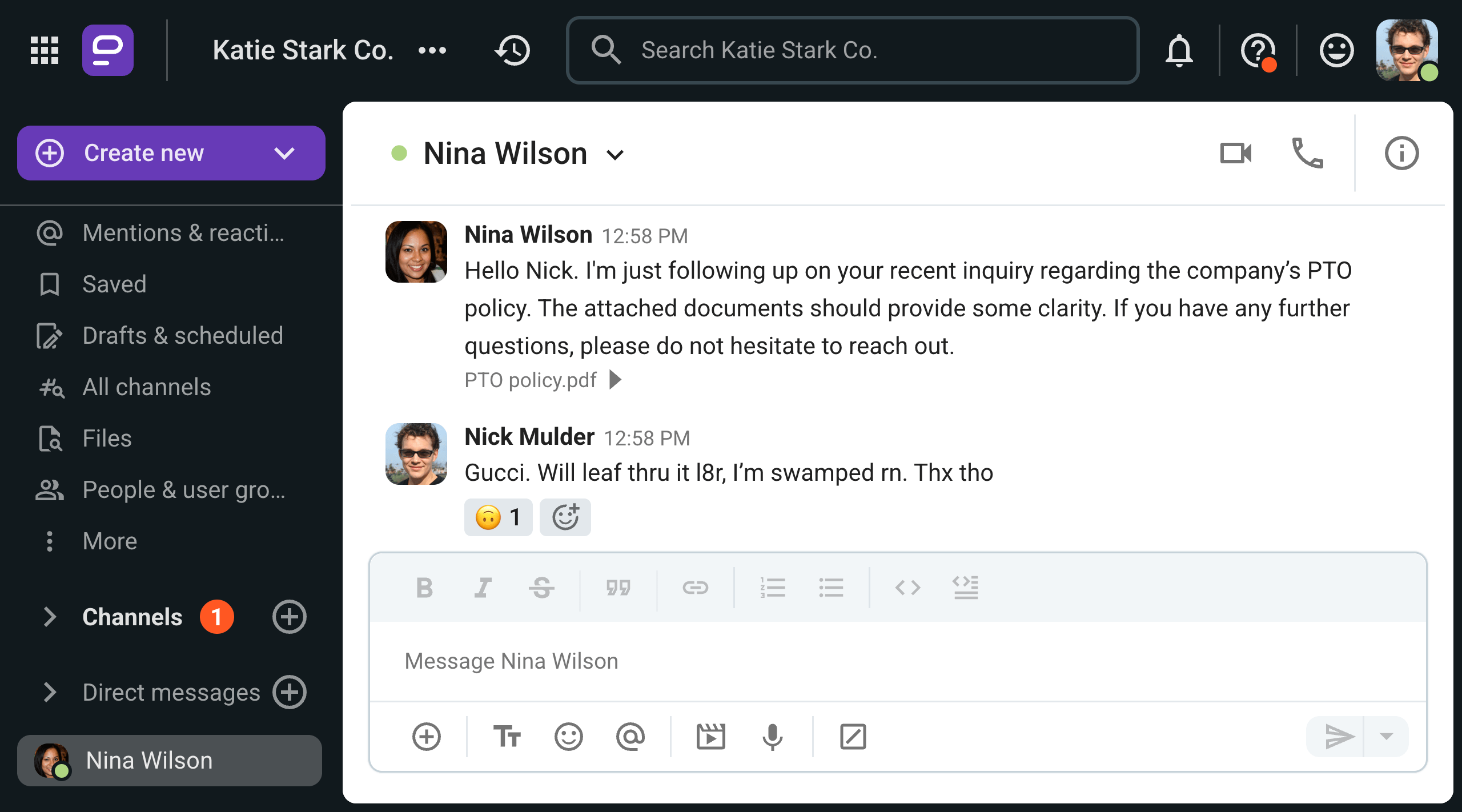
Tip #3: Use company or professional jargon
Since formal communication is a reflection of organizational hierarchies, the way you communicate needs to reflect your authority within your field.
One way to build that authority would be to use the professional jargon of your industry.
For example, if you’re in education, you could be an ECT (Early Career Teacher) teaching ESL (English as a Second Language) in a blended learning (combined in-person and online activities) course.
Create your teaching environment in Pumble
When speaking to other teachers, using this kind of terminology will show that you’re all a part of the same group.
However, formal communication can also encourage the overuse of jargon, as Anitra St. Hilaire noted:

“When done poorly, formal communication can become vague, jargon-heavy, or even weaponized to obscure rather than clarify.”
Remember: one of the main characteristics of formal communication is efficiency, which has the goal of ensuring mutual understanding.
So, make sure your use of professional terminology doesn’t compromise the clarity of your underlying message.
💡 PUMBLE PRO TIP
If you’re not sure what the rules about the use of professional jargon in internal communication are, check out our blog post on that topic:
Tip #4: Avoid using anecdotes
Anecdotes are a colorful way to breathe life into your arguments and conversations.
However, formal communication should be direct and unambiguous.
Anecdotes and analogies are certainly not that.
So, keep it simple and matter-of-fact.
Instead of taking the roundabout way to reach your point, explain your reasoning with facts and numbers.
If you insist on using anecdotes in formal conversations, you run the risk of annoying and alienating your audience, as shown in the Pumble exchange below.
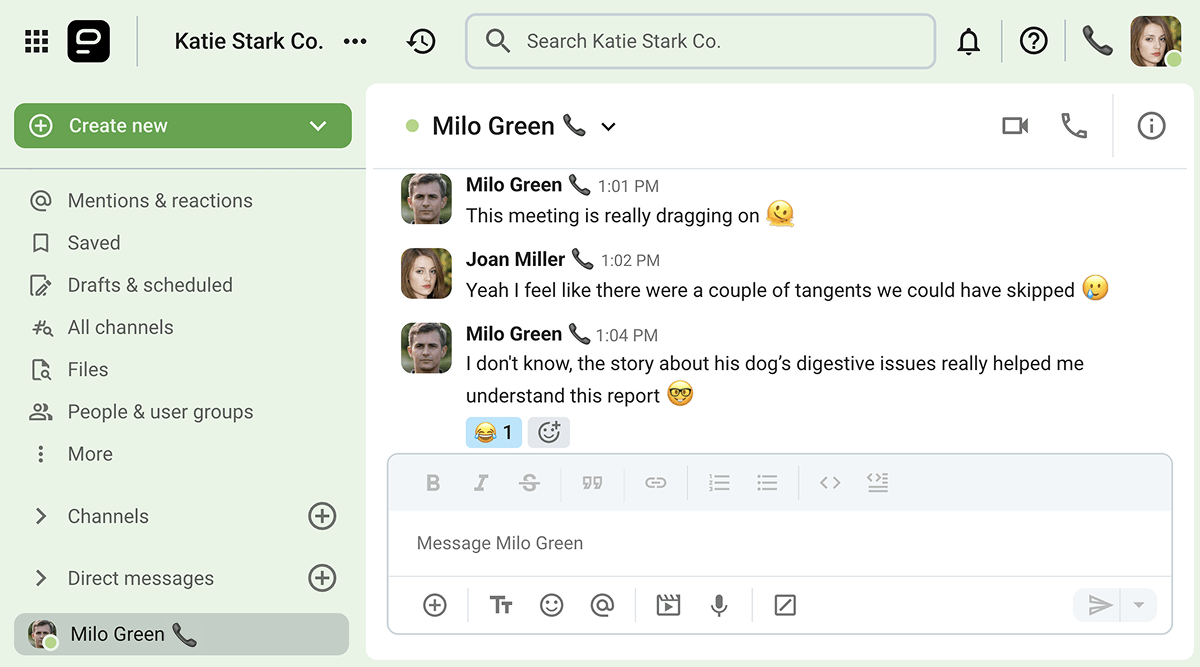
Tip #5: Consider the purpose of your message
So far, our tips have been all about the technical aspects of formal communication, such as your vocabulary choices.
But, if that was all it took to perfect your formal communication skills, you could become an expert simply by improving your listening skills and learning to reflect the way other people speak to you.
Instead, you should focus your energy on perfecting your thought process as you compose your message. Remember: formal communication requires forethought.
With that in mind, Anitra St. Hilaire recommends considering the following questions before drafting your message:

“I’d encourage leaders to ask better questions before they communicate:
- What do I want the audience to walk away knowing?
- Is this understandable to someone without context?
- Does it reflect our values?
- Does it answer the most likely questions?
- Can people find this later, and will it still make sense?
Formal communication should be treated as a living system, not just a static announcement. It should evolve, stay accessible, and be designed to prevent ambiguity.”
Answering these questions before you send out your message should save you some time in the long run, as you won’t have to repeatedly explain what you wanted to communicate.
Enhance your formal communication with Pumble
Ultimately, no matter how laid back and casual your company is, sticking to informal communication won’t keep it going forever.
As Anitra St. Hilaire told us, formal communication is also necessary:

“Formal communication is essential when you need to ensure consistency, clarity, and accountability. This is especially true when the stakes are high or the message affects many people. But relying only on formal communication can create unnecessary distance.”
Luckily, Pumble lets you strike a perfect balance between formal and informal communication on your team.
You can have casual conversations in DMs and designated channels, while practicing formal communication on official channels, where you can:
- Grant certain users exclusive posting permissions,
- Share documents like memos and other reports, and
- Announce meetings for internal teams and even external guests.
Thanks to Pumble’s video recording feature, you’ll also be able to keep even verbal communication on the record, whether you’re:
- Hosting large conferences,
- Having one-on-one meetings, or
- Sharing presentations during calls with the screen sharing feature.
Bring your communication into the future — make a Pumble account today!





